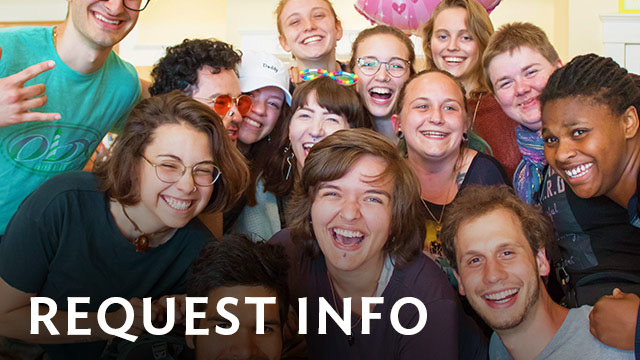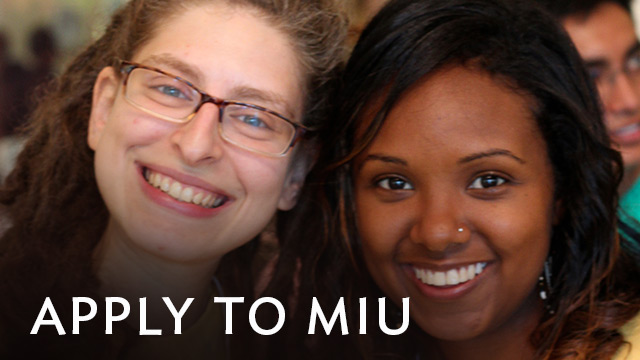- FA 205 Language of Visual Organization
This course provides the knowledge and practical experience of how visual elements are organized by principles universal to the fine and applied arts. Topics include: examining and applying design principles and vocabulary such as figure/ground, interdependence, symmetry, rhythm, shape, and texture; understanding how these principles and their components apply to the scope of the visual arts, including drawing, sculpture, ceramics, photography, graphic design, architecture, fabric design, and landscaping; and understanding and expressing how design principles can be correlated to the balance and order of nature, the universe, individual and societal life. Materials fee: $45 (4 credits)
- FA 217 Drawing 1
In this course, students develop powers of observation and imagination, abilities that are vital for all the arts. Students focus on establishing the use of principles of drawing through observational methods. Topics include: still life, figure drawing, interior and landscape. Art majors take drawing courses as they advance through the curriculum. May be repeated for credit with permission of the instructor. Materials fee: $35. (4 credits)
- FA 218 Painting 1
Painting expresses the artist’s connection with the deep laws fundamental to seeing and creating visual images. Students are immersed in the fundamentals of drawing and painting from nature and a variety of other subject matter. The curriculum addresses the students’ development of formal and technical skills along with a conceptual and critical understanding of the language of painting as preparation for independent studio work. May be repeated for credit with permission of the instructor, subject to satisfactory progress in the previous course and a clear plan for the progression of learning in the subsequent course.
- FA 381 Paleolithic Art through Art of the Middle Ages
To many, the term ‘Ancient art’ might suggest that which is, first and foremost, old and far removed from the contemporary concerns of today’s artist or art student. Such a perception would be inaccurate, however, for the so-called Ancient Cultures comprise those stages of societal development when Western Civilization was in its infancy and its burgeoning youth. The artistic legacy of these early cultures speaks to us today, communicating across time, on the fine level of feeling, in images that are startling in their freshness and purity, and reminding us of the timeless continuity of collective consciousness.
- FA 382 European Art from the Renaissance the Late 19th Century
Beginning in the latter half of 15th Century Europe, a profound synthesis of art, philosophy and culture took place within collective consciousness, which greatly affected the evolution of society and the images it produced for centuries to come. We will explore how this synthesis differentiated itself, under such burgeoning influences as Secularism, Humanism, and the Objective World view, to unfold a rich progression of artistic styles and attitudes. Styles include: Pre-, Early, High, and Northern Renaissance, Mannerism, Baroque, Rococo, Neoclassicism, Romanticism, French Naturalism, etc.
- FA 385 Modern to Contemporary Art
Beginning in the late 19th Century, and especially into the 20th Century, the ‘look’ of art changed so rapidly and radically that for many it seemed to defy all sense of connectedness to the traditions of art that preceded it. Has such change been the result of capricious discontinuity, or an understandable expression of the dynamics of collective consciousness and ever-changing cultural contexts? This course will examine the How and Why of Modern Art up to the 21st Century. Although drawing appropriately on the fields of Philosophy, History, Art Theory, etc., and involving classroom discussions and critical writing assignments, this course, like other courses in this series, will be centered around extensive, purposeful visual focus. For those students already familiar with many of the forms of Modern Art, here is an opportunity to more deeply appreciate and understand those forms within the fuller context of their cultural and historical connectedness.
- FA 386 The Art of Non-Western Cultures
As rich and compelling a narrative the Art History of Western Civilization may be, the visual vocabulary of today’s artist or art student would be incomplete without a basic familiarity with the forms and images produced by societies whose respective world views differ uniquely from that of Western Culture. Alternate ways of perceiving and visually representing values like nature, the flow of time, the cosmos, and mankind’s role in it, further substantiate the universality and diversity of the expressive nature of consciousness. Moreover, this course offers an opportunity to explore new vistas of aesthetic possibilities and formal expression to any aspiring artist or student looking to expand their sources of creative inspiration. This course will serve as a foundational, visually oriented survey of image-making traditions from such areas of the world as Sub-Saharan Africa, Eastern Asia, India, Mesoamerica, and Oceania. An additional feature of the course will be the consideration of the many instances over time in which non-Western art has significantly influenced the course of Western art.
- FA 340 Ceramics Studio
- Topic 1: Hand-building in low-fire earthenware clay, drawing inspiration from ancient origins to contemporary masters
- Topic 2: Exploring the relationship between surface and form in thrown and hand-built forms using high-fire stoneware clay
- Topic 3: Addressing the image on hand-built, low-fire earthenware forms
- Topic 4: Exploring the limits of function in hand-built and thrown high-fire stoneware forms
Students at all levels in ceramics will increase their studio skills related to forming, understanding glazes and other surface possibilities, plus various firing methods. Faculty and peer interaction is structured to support the integration of method, meaning, and function (depending on the individual student’s need) to express the inner value of consciousness in matter in this medium. In some studios, wheel throwing opens a new dimension of experience for the student potter. The challenge to center and form a pot while the clay is spinning through the hands leads to a synchronicity that powerfully connects potter and pot, awareness and matter, in the process of creation. Students are exposed to the traditions and history of ceramics that continue to emerge worldwide.
- FA 352 Sculpture Studio
This course concerns itself with spatial and structural relationships in sculpture. Exploration in form, context and installation are addressed. Students learn to realize ideas in form with consideration of delivery through an understanding of the deeper organizing principles that underlie three-dimensional space. Methods include constructive, additive and subtractive processes involving various prescribed and found materials.
- FA 475 BA Portfolio and Final Project
The BA Portfolio and Project, taken in the final semester, completes the BA degree in art. Guided by faculty, BA candidates work independently in the studio to create a series of work. They then photograph their work to create a digital portfolio. Students also keep a journal and reflect on their experience studying in the Department of Art. The portfolio, journal, and written reflection form the basis of a 7-minute oral presentation sharing the student’s growth of creativity, art, and consciousness while at MIU. (4 credits)
 In our block system you’ll study one full-time course per month, giving you the time you need to dive deeply into each subject. You’ll be immersed in each studio class without the stress of juggling multiple courses and assignments.
In our block system you’ll study one full-time course per month, giving you the time you need to dive deeply into each subject. You’ll be immersed in each studio class without the stress of juggling multiple courses and assignments. MIU’s experienced faculty have proven track record mentoring student artists. Small classes with personal guidance from faculty facilitate your success. The faculty care about your well-being as an artist and as a person. They will help you create a sustainable studio practice that enables your creativity to flourish and supports a healthy, happy life.
MIU’s experienced faculty have proven track record mentoring student artists. Small classes with personal guidance from faculty facilitate your success. The faculty care about your well-being as an artist and as a person. They will help you create a sustainable studio practice that enables your creativity to flourish and supports a healthy, happy life.

 Adriene Crimson is this program’s admissions counselor for US students. Adriene will provide you with all the details of becoming a student, including connecting you with the program director or faculty.
Adriene Crimson is this program’s admissions counselor for US students. Adriene will provide you with all the details of becoming a student, including connecting you with the program director or faculty. Within our BA, we offer four sequential certificate programs for you to become proficient in specific materials and techniques as you build toward your art degree or use a certificate to bolster your degree in another field:
Within our BA, we offer four sequential certificate programs for you to become proficient in specific materials and techniques as you build toward your art degree or use a certificate to bolster your degree in another field: As a student in MIU’s BA program, you’ll practice the Transcendental Meditation technique daily. This evidence-based technique reduces stress, enhances clear thinking, and gets you in touch with your inner self—the deepest, most authentic part of yourself—to help you create your best work.
As a student in MIU’s BA program, you’ll practice the Transcendental Meditation technique daily. This evidence-based technique reduces stress, enhances clear thinking, and gets you in touch with your inner self—the deepest, most authentic part of yourself—to help you create your best work.




 This course is your entryway into MIU and Consciousness-Based Education. We dive into an ancient yet radically new framework for understanding the universe and our place in it. This model holds that consciousness, not matter, is fundamental. With this in mind, we look at some of life’s big questions: How can we develop our fullest potential as human beings? How do art and stories help us understand that potential? How can our own growth help create a more just and peaceful society? What do the world’s great wisdom traditions have in common? How can we improve education and healthcare? The new paradigm we explore in this course infuses all your classes at MIU. In this course, you'll learn the Transcendental Meditation® technique to awaken the full potential of consciousness in your life.
Comments from students
This course is your entryway into MIU and Consciousness-Based Education. We dive into an ancient yet radically new framework for understanding the universe and our place in it. This model holds that consciousness, not matter, is fundamental. With this in mind, we look at some of life’s big questions: How can we develop our fullest potential as human beings? How do art and stories help us understand that potential? How can our own growth help create a more just and peaceful society? What do the world’s great wisdom traditions have in common? How can we improve education and healthcare? The new paradigm we explore in this course infuses all your classes at MIU. In this course, you'll learn the Transcendental Meditation® technique to awaken the full potential of consciousness in your life.
Comments from students












